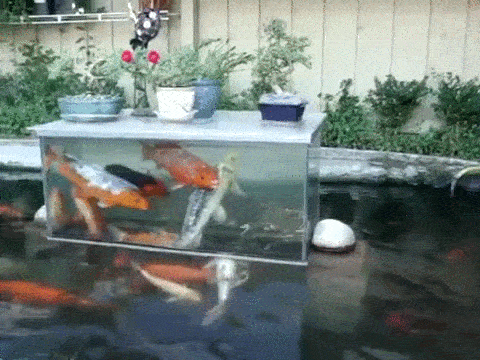Latest Posts by linruuu - Page 9

Cat mute for euphonium.
Video/caption/photo by Kazuhiro Tsukimura
I’m hornet af
What’s a nudibranch, anyway?

These soft-bodied mollusks are closely related to sea slugs!

“Nudibranch” means “naked gills,” referring to the fact that they carry their gills on their back. Here’s a closeup of nudibranch gills:

Many nudibranch species are spectacularly colorful, from the Spanish shawl nudibranch, found in Channel Islands National Marine Sanctuary:

to the opalescent nudibranch of Cordell Bank National Marine Sanctuary, which preys on hydroids and anemones. During digestion, the hydroid and anemone stinging cells actually travel into the nudibranch’s colorful appendages and can be used against the nudibranch’s own predators!

Nudibranchs are found all over the world’s ocean and in many of your national marine sanctuaries.

What’s your favorite kind of nudibranch?



I like the corner seat.
僕は隅っこに座るのが好き。







Wolf pup howling for the first time

I can feel…the serotonin and dopamine dropping…i need to make…Crafts
i must make…
b e a d l i z a r d

just saw an x-ray of a horse skull. can’t say i’m too happy with it

rare tree: *appears on college campus and persists undetected for decades*
campus tree scientists:
READ MY LIPS
TIME FOR WEIRD BIOLOGY.
and this week’s creature feature looks like something that could be found in the cosmetics section… of an interdimensional hellmarket catering specifically to Elder Gods.
it’s a trendy shade of sultry scarlet and it lives on the edge of boiling geysers at the bottom of the ocean- give it up for the-


it looks like evil spaghetti.
the Giant Tube Worm was discovered in the icy hell-depths of the Pacific Ocean waaay back in 1977. I would pay actual money to hear what the very first researchers to gaze upon a writhing field of these things were thinking. (“hur hur it looks like evil spaghetti”, perhaps. I can only guess.)
but I mean, if I went to the bottom of the ocean and found an immense field of previously unknown 8-foot-long worms waving their mouthparts gently from inside bone-white protective tubes? my response would probably just be screaming.

can you blame me? really?
but what actually are these bizarre creatures? well, for once the name is absolutely correct. the Giant Tube Worm is a worm, and a distant cousin to the pink shoelace creatures that flop onto the sidewalk and die after a rainstorm. (but you wouldn’t be able to tell from looking.)
these extremely secret creatures live at depths of over 5,000 feet, where no light reaches and the pressure is enough to reduce an African Elephant into a sad grey pancake. this doesn’t bother the Giant Tube Worm! (the pressure, not the concept of flattening an innocent elephant. though worms have no morals and their advice CANNOT be trusted.)

INVEST YOUR LIFE SAVINGS INTO CRYPTOCURRENCY.
but aside from the pressure, the Giant Tube Worm tolerates conditions that we usually only think of existing on other PLANETS. like, the bottom of the ocean is ice cold, right? (if you didn’t know that before, you do now.) the bottom of the Pacific Ocean hovers maybe a few degrees above freezing. (cold enough to freeze an African Elephant! we’re picking on elephants today, I guess.)
at least, MOST of the ocean floor. see, the Pacific Ocean is littered with thousands of volcanic vents, ranging from actual goddam volcanoes (like All Of Hawaii) to 30-foot tall underwater geysers that spew superheated water and deadly toxins from the Earth’s mantle.
guess where the Giant Tube Worms live!

no no, YOU HAVE TO GUESS.
that’s right! out of all the hellish places on earth, this animal looked at one that was already nightmarish and said “hm. not awful enough.” and moved next door to a boiling poison factory. just for the hell of it.
these aptly named “black smokers” can reach temperatures of well over 800 F (HOT ENOUGH TO BOIL AN AFRICAN ELEPHANT) and release the extremely lethal compound Hydrogen Sulfide (TOXIC ENOUGH TO POISON AN- yeah okay, I’ll stop) into the water. it sounds deadly to us, but for a Giant Tube Worm, this is prime real estate! and it’s because they’re basically aliens.

take us to your leadderrrr.
not only can Giant Tube Worms withstand extreme temperatures from boiling to freezing, they actually EAT those toxic chemicals! sort of. it’s complicated.
I’ll start simple: the Giant Tube Worm doesn’t have a full digestive system! where most creatures have a stomach and a lot of gross tubes, the Tube Worm has… symbiotic bacteria. and a LOT of them. these bacteria can make up half the Tube Worm’s goddam body weight! gross.
but these aren’t just any bacteria! these are the tube worm’s tiny life partners- they’re are able to use chemosynthesis, which is like photosynthesis but more complicated. basically, they use oxygen in the seawater to break down toxic compounds like hydrogen sulfide into food and energy! it’s a neat little system with no loose ends. loose ends are for filthy surface dwellers.

eels are okay, though.
but how is the tube worm even getting these compounds? well, it’s all in the lips. (stand by, things are about to get EVEN WEIRDER.)
those “lips” are actually an appendage called a plume. it’s bright red because it’s full of hemoglobin. if you paid attention in health class and didn’t faint like SOME people (shut up, I’m just a little squeamish!) you know that this is the same thing that makes human blood red. (and also elephant blood.)
the plume absorbs chemicals and oxygen from the water, and is so efficient that Giant Tube Worms are one of the fastest growing marine invertebrates! they’re extremely difficult to study for obvious reasons, but scientists think they may reach adulthood in just two years.
clearly, this eating-chemicals thing pays off.

kids, DON’T TRY THIS AT HOME.
because of their life choices, Giant Tube Worms enjoy an existance largely cut off from the rest of life on earth. (a darker, writhe-ier existence.) because of this, these incredible animals are little effected by human domination. (except when we go down there and shine bright lights in their faces, anyway.) however, Giant Tube Worms are part of the web of life like the rest of us. (NOBODY GETS A PASS. NO. BODY.)
see, the oxygen they use for chemosynthesis isn’t from the black smokers, or even really from the ocean. that oxygen came from photosynthesis, making the Giant Tube Worm as dependent on plants and the sun as the rest of us. it just goes to show, we’re all connected even if we think we aren’t! thanks, Giant Tube Worm!

PLAY SOCCER IN A BUSY INTERSECTION AND EAT A HOTDOG YOU FOUND ON THE GROUND.
–
thanks for reading! you can find the rest of the Weird Biology series here.
if you enjoy my work, maybe buy me a coffee or check out my Patreon to see extra content and support Weird Biology.
–
IMAGE SOURCES
img1- ResearchGate img2- BBC img3- Wikipedia img4- University of Melbourne img5- NOAA img6- NSF img7- Peter Batson img8- Deep Sea News


These images are floating around and it’s said that these are “skeleton panda sea squirts.” Elsewhere I’ve searched calls them “Gaikotsu Panda Hoya.” Perhaps different names for the same thing. I’m not 100% sure, though.
i’ve said it before but it genuinely bothers me so much that every convo about animal welfare in ag is so wrapped up in things that are blatantly untrue/things that aren’t actually bad because there ARE problems with welfare (and environmental impact) but no one in ag can ever take time to talk about them because people want to scream about “rape racks” and snapping the legs of every sheep as they’re sheared

There are currently two northern white rhinos alive on planet earth. They are a mother and daughter named Najin and Fatu and neither is capable of carrying a pregnancy. The last male of the species, Sudan, died of old age last year.
You’d think these bleak facts would guarantee certain extinction, but scientists at Avantea have now successfully fertilized 7 eggs taken from the two female rhinos with frozen sperm from deceased males of their species.
If the eggs develop successfully, the next step will be to implant one into a female southern white rhino to carry the pregnancy. This is the first time a procedure like this has been successful, and it opens up a huge number of possibilities not just for northern white rhinos, but for critically endangered species everywhere.

It’s not easy studying birds. They fly away for months at a time, and even if you can track them down again, their frivolous texting habits threaten to leave you utterly penniless.
That’s what happened to a team of Russian scientists in Siberia, whose research budget blew out when the migrating eagles they were tracking hit a costly snag all high-flying travellers fear: global roaming charges.
Continue Reading.
‘Green gold’ tree offers Brazil deforestation hope

Trees that help keep soils fertile could slow or stop deforestation in Brazil’s “arc of destruction”.
A project using inga trees hopes to show smallholders that they can earn a decent living from the land.
“It’s very much a kind of ‘miracle tree’ or a super tree because some of the species can do some amazing things,” said Toby Pennington, professor of tropical plant diversity and biogeography at the University of Exeter, UK.
“They can grow really fast on very, very poor soils, even soils where a rainforest has been cut down and have become very degraded.”
The trees (there are more than 300 species) are in the legume family and that means they can fix atmospheric nitrogen into the soil.
“More than that, these species have fruits that are edible and often have local markets right across Latin America.”
The trees can also be coppiced, providing wood fuel, and the leaves are a good source of forage for cattle.
As the tree was common and found throughout the Amazon Basin it was deemed to be a miracle tree or super tree by projects trying to stem the relentless deforestation in the region.
Continue reading.
who was the first person to write “tongues battling for dominance” and have they issued a public apology yet

Mark Oliver Everett, Things the Grandchildren Should Know










this is what happens when you make a horror movie with an all gay cast
Me as a demon


strawberry picking!! 🍓 | 1:03 pm











